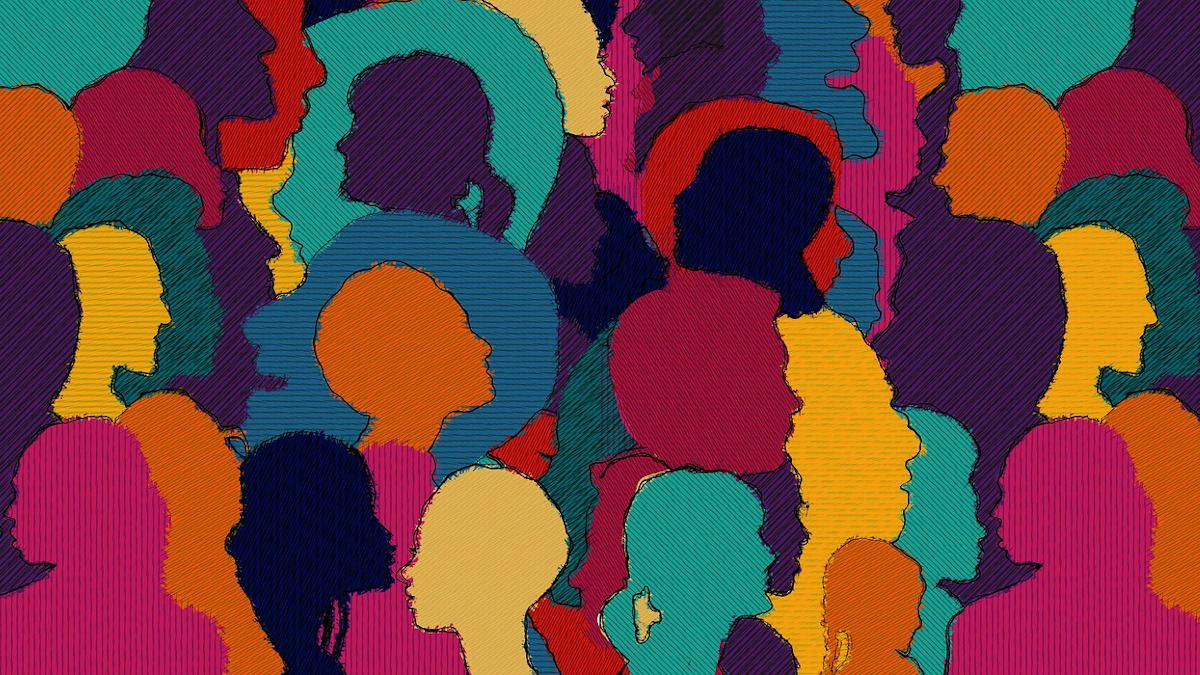Hiring for cultural richness can be a bit counterintuitive when we are conditioned to hire for cultural fit. Cultural fit helps to remove friction from the conversation. If everyone has the same thoughts, there is no opposition and no arguments. However, there is also no innovation and no one to point gaps in our thinking. With a more diverse workforce, you can expect more conflict but also more innovation. You automatically increase your future potential as an organization.
I certainly don’t want to dismiss the importance of cohesive culture. The importance of organizational culture is clearly illustrated in various mergers and acquisitions. More than half of mergers lose value. It is not because of bad business decisions but because of ignoring the cultural divide between the two companies. Money is lost because people don’t know how to deal with their differences.
What is diversity
Historically, human resources departments focused on rooting out discrimination, harassment, racism, and other forms of unconscious bias. The goal was to make the workplace less toxic but not necessarily more inclusive and diverse. It was the necessary first step but more needs to follow. Diversity is a broader topic than just race, age, or gender.
Nigel Bassett-Jones defines diversity management as “a planned, systematic approach to recruiting and retaining employees of diverse backgrounds and capabilities.” It is not only about diversity in terms of gender, ethnicity, or religion, but also of lifestyle, ability, culture, and intellectual capacity. It includes different personalities, work styles, educational and cultural backgrounds, communication styles, a nation of origin, career path to date, or industry background. Inclusion then means training people to embrace various communication styles, personalities, different ways of decision-making, accepting perspectives different from our own.
Advantages of diversity
In Dream Teams, Shane Snow points to interesting statistics. Women form 12% of cops in the USA but are involved only in 2% of shootings. More importantly, on a cop for cop basis, they are as successful at stopping crime as men. They are just much less likely to use excessive force and solve problems with less collateral damage.
The reason for this difference starts with different views of the world. Snow explains this on an example of a padlock. When male cops are confronted with a locked padlock, they will try to break it or otherwise physically compromise to get it open. Women, on the other hand, will try to subvert it psychologically. They will try to find the key or persuade the person who locked it to open it.
All this is important for one reason. Teams comprised of individuals with diverse mental models are more likely to outperform more homogenous groups even if the homogenous groups consist only of the top talent.
Even the mere presence of someone different can change the way we think. As Snow points out, if you get a group of people designing a building, and then a person in a wheelchair joins the group, everyone will start thinking differently. The building will become better designed for disabled people by virtue of diverse thought that goes into the process. The same applies to any group and projects you can imagine. Diversity promotes creativity.
Even though the conversation about diversity is getting decent momentum, very few companies are truly embracing it. It is one thing to do what is right and another to do what brings in more revenue. Efforts like the one of Boston Consulting Group are helping to remedy that and show how a diverse leadership team directly helps increasing revenue. Companies with above-average diversity in their leadership teams reported innovation revenue of 45%. In contrast, those with below-average leadership diversity had only 26% of total revenue coming from innovation. In this case, revenue from innovation means revenue from products or services launched in the last three years, which is critically important in today’s fast-paced business environment.
When it comes to gender, the story is the same. More women in management roles as opposed to purely male teams lead to more innovation revenue. According to the study, companies with the greatest gender diversity generated 34% of their revenues from innovative products and services while those with the least gender diversity only 25%. The evidence also suggests a high percentage of female managers leads to more disruptive innovation where the new product or service replaces the one that existed before.
Why diversity efforts fail
Unfortunately, our biology works against us when it comes to building diverse groups. Through evolution, the human brain came up with a mechanism to quickly evaluate potential threats and react on pure instinct rather than processing risks through reason—fight or flight. When you encounter a tiger, you don’t spend time thinking about whether it is here to help you. On pure instinct, you start running, and only then do you start thinking about the best course of action. The same applies when you meet someone who looks very different from you. Your subconscious impulse is to fight or flight. In the corporate world, it is often the fight option. Anyone who is not part of your in-group is suspicious and to be feared. That is where the word xenophobia comes from. It is an ancient Greek word for “fear of strangers.”
What used to work in the good old days of hunter-gatherers, where you rarely came up across humans, not from your in-group, is exceptionally unhelpful today when you are surrounded by out-groups everywhere, and need to collaborate with them to make things happen.
People generally prefer to interact with others who are similar to them, have the same beliefs, and exhibit similar behaviors. They are easier to interact with, more predictable, and the interaction reinforces our belief system. It is easier to feel we are right and that we belong. We prefer homogenous groups as opposed to heterogeneous ones. Heterogeneity, in our context, is the same as diversity. It simply means the presence of “difference” within the team. Interacting with someone very different takes more effort. If you leave people to their own devices, they will take the easier road and attach to someone similar to them. It is the most visible when hiring new colleagues to the team. To recruit diversity into the organization, you need to be very deliberate and forceful about it. It is not going to happen on its own.
Bigger heterogeneity weakens identification with the group and thus increases coordination and motivation costs. It takes more managerial effort to keep the heterogenous group together and focused on the same goal. There is less intrinsic motivation of its team members in bigger groups to build relationships with others than in a smaller group. Interactions are generally more formal and less interactive, which again works against relationship building.
More diversity makes the teams smarter and more innovative, but it also creates more conflict. Unfortunately, the increased conflict is then being used as an excuse that diversity doesn’t work. Nigel Bassett-Jones calls this a paradox of diversity management. As he points out, “diversity is a recognizable source of creativity and innovation that can provide a basis for competitive advantage. It is also a cause of misunderstanding, suspicion, and conflict in the workplace that can result in absenteeism, poor quality, low morale, and loss of competitiveness.” It is not only an increased conflict, but employees who feel they are different from the rest of the group feel less emotionally attached and more likely to leave. It often leads to a perception of the majority of the group that those who are different don’t want to be here and may encourage hiring a more homogenous group in the future. How do you resolve that?
There is enough research into observable diversity to understand that higher diversity attributes to higher turnover, lower commitment to the team, higher absenteeism, and lower performance ratings. Heterogeneity in skills, education, and domain expertise have larger cognitive outcomes than affective ones. It accelerates innovation and creativity while it hinders attachment and productivity.
It is common sense. When people with diverse opinions collide, there is friction. If the group’s tension gets too high, things break, the group is in disarray, people leave. The art is to keep some tension that leads to people challenging each other but in a respectful matter. This then leads to new ideas without the group breaking.
Even the metrics human resources departments use are not helpful and often go against building a robust and diverse organization. For example, an oversized focus on retention may lead to managers hiring more homogenous groups that will be easier to retain. Building an inclusive, diverse environment means focusing on metrics that will show off its strengths.
It is not only metrics, systems, and processes. The leadership team needs to be trained to understand the challenges of building a diverse environment. And more importantly, the team needs to be committed to it. This is the most critical aspect. Companies often use the PR focused approach like “let’s hire a diversity officer and be done with it.” Unfortunately, once you have a person dedicated to diversity effort, the rest of the management team may get convinced that diversity is no longer their problem and outsource the work to this dedicated person. It can’t work. Only by everyone on the management team committing to building a diverse and inclusive organization, having the maturity and emotional intelligence to develop personal relationships with everyone on the team, can it succeed.
Build the right environment
Diversity requires a regular review of what works. It requires identifying the best approaches and amplifying them across the rest of the organization. The most critical conditions of the work environment that make diversity work are:
Prioritize diversity and inclusion – you need very visible support from the top leadership. If the C-level team doesn’t visibly act in ways that support diversity, your efforts won’t have the desired impact. It is not only about paying lip service. There needs to be a clear indication that the top management team leads by example.
Adopt participative leadership style – managers need to listen to their employees’ suggestions. There is little point in hiring a diverse team if you don’t plan to listen to their ideas and will shut down every suggestion with “that’s not how we do things here.”
Build trust and encourage constructive conflict – for the organization to truly take advantage of the diversity efforts, it needs to build trust. People must care about others who are different from them and must be able to trust them. At the same time, you need to know how to argue. Conflict, dissent, and discord are essential for genuinely high-performing organizations. People must be willing to argue for their ideas with passion. And they must be able to do it in a way that leads to a constructive outcome rather than a dismantled team. Psychological safety is critical. Everyone must be able to raise their voice, present their opinion, debate alternatives, and freely disagree even with their bosses. Of course, once a decision is made, then everyone needs to align behind it and execute.
Focus on interpersonal communication – people tend to avoid those who are different. That’s a human nature acquired over millions of years. Encourage and facilitate dialog between people with diverse backgrounds to spark innovation.
Create equitable opportunities – your policies and practices need to support your diversity efforts. Understand the difference between equity and equality. Make sure your pay policies, developmental opportunities, career advancements are fair and truly available to everyone. Everyone needs to feel they belong.
Putting it all together
When researchers focus on diversity, they often look for its impact on productivity and team cohesion. It is the organizational perspective that is being researched. It is logical as that is what the companies focus on too. It leaves behind another aspect—the human or moral aspect. Building a more diverse team promotes equitable opportunities. Even if it may impact productivity and create a bit of friction, it is still the right thing to do if you call yourself a human being. Claiming that diversity has only positives is doing a disservice to the effort. People in the organization can see by their own eyes and experience first-hand also the negative aspects. If the management team tries to push diversity by false claims of improved productivity, it will be counterproductive. Employees will resent it. It is much more powerful to be transparent about the benefits and possible issues and focus more on the emotional aspect explaining that it is the right thing to do while putting in place processes, policies, and training that mitigates the increased friction.
High-performance organizations are not those that limit conflict but those that prefer an outcome-driven approach to management. Conflict is acceptable if it leads to stellar results. It is also more and more question of well-designed teams with complementary skills. When you hire a person, you should consider their functional competence and preference for a type of work and how they complement the rest of the team. Then there needs to be a constant effort to keep the team together. Homogenous groups bond more quickly than heterogeneous groups. To take advantage of the diversity of thought, you need to put in place processes that will keep the diverse team together. You need to be much more proactive in creating a sense of belonging for everyone, building a feedback culture, promoting a healthy debate, and empowering managers to implement the employees’ ideas so the team can deliver results. Diversity, as well as innovation, won’t work in an environment where the standard answer is “that’s not how we do it here.”
Diversity works because it brings pain. You can compare it to physical exercise. If you want to perform well in a competition, what do you do? You train. You don’t take the easy road. No, you work hard, you push yourself, and your muscles grow—the same with diversity. You get out of your comfort zone. You know that you will have to win over someone different from you, so you prepare harder, you have a better argument, you are more creative, you think about different perspectives. Even before the interaction, the product of your thought process is already vastly better than if you worked in a homogeneous environment. That’s how diversity works.
What is your take on the topic? How do you build a more diverse culture at your organization? Do you even try? What are the benefits and the drawbacks? What major failures did you experience?
Photo: geralt / Pixabay.com
For more follow me on Twitter: @GeekyLeader






Leave a Reply